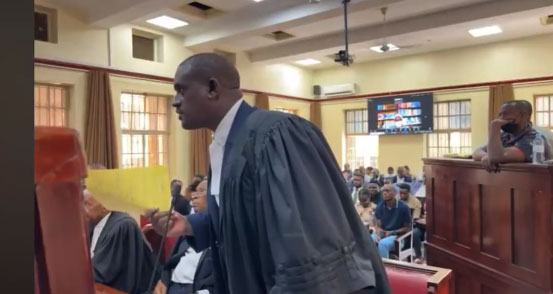
Kampala, Uganda | THE INDEPENDENT & URN | The defense team in the high-profile murder trial of Henry Katanga continued its cross-examination of state witness number 11, Derrick Nassawali, the head of ballistics in the Uganda Police today. Nassawali, the police’s ballistics expert, admitted he could not definitively rule out whether the case was a homicide or a suicide.
During the session, defense lawyer Elison Karuhanga questioned Nassawali on the findings, particularly regarding the fact that the deceased was killed by a single bullet. Karuhanga questioned ,”with no other bullet fired, you can’t come to the conclusion that this was a suicide?”
“I don’t have information to conclude whether there was a homicide or suicide,” Nassawali replied
Further cross-examination revealed inconsistencies in the forensic evidence. The toxicology report was described as inconclusive, with Nassawali admitting that components of gunpowder residue could also be found in perfumes, nail polish, lotion, body creams, hospitals, or gloves.
Additionally, the defense challenged the gunpowder testing procedure used in the case. While the prosecution argued that Nassawali’s method was valid, the defense pointed out that it differed from the procedure recommended in the 2023 crime scene procedure manual. Nassawali dismissed this manual as outdated, but the defense reminded him that his superior, Andrew Mubiru, the Director of Forensics had testified in the same case affirming that the police currently follow this manual.
Are lawyers also taught how bullets and guns work?
In the #UgandaVsMollyKatanga case today, defense lawyer @elisonk got into it with the @PoliceUg ballistics expert.
In a session where the defense got the state witness to admit that he couldn’t rule out either of homicide or… https://t.co/f73nGdhoWA pic.twitter.com/jpElHMiZbs
— Anthony Natif (@TonyNatif) April 1, 2025
A major revelation during the hearing was Nassawali’s acknowledgment that the accused, Molly Katanga, had suffered broken index fingers and fractures in both arms at the time of the shooting. When asked if it was doubtful that someone with such injuries could aim and fire a gun, Nassawali stated that it could be possible if the person was well-trained, but he admitted it was highly doubtful.
Another point of contention arose when the defense highlighted an inconsistency in forensic results. Two swabs labeled M2 and M3, which were supposed to be identical replicas, yielded different results. This discrepancy raised serious concerns about the credibility of the forensic findings, with defense lawyers questioning how such a contradiction could occur.
As the session neared its conclusion, tensions between the defense and prosecution escalated. The defense moved to have all forensic evidence provided by Nassawali thrown out, arguing that his appointment lacked legal authority as he was not appointed by the minister through a statutory instrument, as required by law. When questioned, Nassawali admitted that he did not possess such an instrument.
The defense cited section 43 of the Trial and Indictments Act to call for the court to throw out all the expert’s evidence because he is not appointed by the minister as required by law.
With the courtroom gripped by these revelations, the prosecution requested an adjournment until tomorrow to allow them time to re-examine their witness.
 The Independent Uganda: You get the Truth we Pay the Price
The Independent Uganda: You get the Truth we Pay the Price



